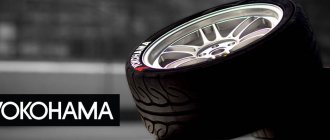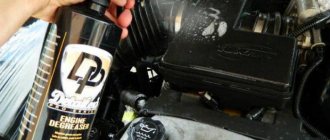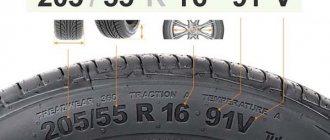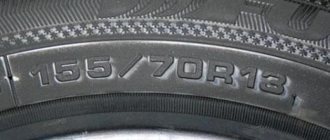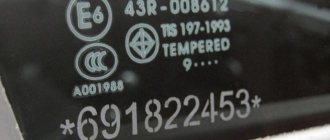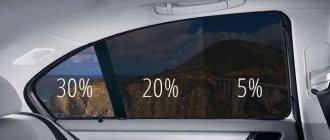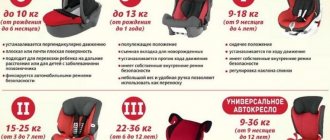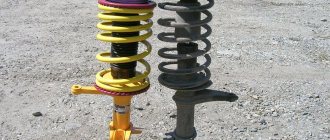A lot depends on the right choice of shoes for your car. When deciding to purchase a kit, you can be guided by various comparative tests. However, it is worth remembering that their characteristics must correspond to operating conditions. In this case, the information indicated in the markings on the sidewall of the tire will help. Such inscriptions on the tire indicate the size of the product and its technological characteristics. Below we will decipher the symbols and try to figure out what the numbers and letters in the rubber markings mean.
Where to indicate the standard size and its interpretation
Tire markings have mandatory and optional designations.
So, on each tire the manufacturing company, the brand of the rubber itself and the tire size will be indicated. The three-digit designation on tires indicates the wheel size in inches, tire width and profile height. The numbers are located on the outside. We have a wheel with parameters, for example, 195 60 R16. This means that we have tires in front of us with a tread width of 195 mm. The second number is the ratio of the picture's height to its width. The higher this parameter, the more “grippy” the tire will be. This value is usually called the profile indicator. The third number is the tire's inner diameter in inches. In general, a common mistake is that motorists purchase wheels without paying attention to some data on changes in external parameters. For example, size 185 65 r15 will differ in height from 210 65 r15 with the same bore diameter. The ratio of the profile to the width in our case may interfere with the installation of tires on the car. This factor should be understood and taken into account. A special calculator will help you correctly calculate tire sizes.
Size
This is one of the most important characteristics of any tire, which is what any car enthusiast pays attention to first. But, judging by eye, it’s easy to make a mistake, so the tire sizes should be looked at on the tires themselves.
For example, a tire designated 185/75R16C has an inflated tire width of 185 mm. This width is measured between its side surfaces. The number 75 is an indicator that shows the profile height as a percentage of the width. This is the distance from the rim to the top of the tread. In our example, the height will be 185 * 0.75, that is, 138 mm.
Example of marking 225/45ZR17 with profile height 101 mm
The letter R is a design index that means the radial type of tire, from the word Radial. This is the most common type now. The number after the letter R is the diameter of the rim in inches that this tire fits.
The letter C in this designation indicates that the tire is reinforced and can be used, for example, on minibuses.
That is, even if you already understand what the 185/75R16 type marking means, you will be able to choose tires of the desired width, height, and the desired wheel size.
But the height is not always clearly marked, so you just need to know that in this case it is a percentage of 0.8-0.82 of the width. If the ratio is different, then it is indicated.
Sometimes the problem arises of how to correctly read the markings of tires made in the USA, for example, this one - 35/12.5R15. Everything here is approximately the same, only the dimensions are indicated in inches, and 1 inch is equal to 25 millimeters. The first number means the full diameter of the tire - 35 inches, the second 12.5 means the width, also in inches. R15 means the diameter of the rim in inches.
Speed indices
Also, tire manufacturers are required to provide all tires with a speed index. This sign can be found immediately after the wheel size indicator. It talks about the maximum speed you can travel on the roads. A table that deciphers the speed index of passenger car tires will help you read this sign correctly.
| Tire classification by speed | |||||||||
| Designation | N | P | Q | R | S | T | U | H | V |
| Speed | 140 | 150 | 160 | 170 | 180 | 190 | 200 | 210 | 240 |
What does tire size mean?
How to choose tires if you don't understand the sizes? Very simple!
Option one. The easiest way is to call Express-Shina specialists at 8 804-333-00-41 or ask a question (indicating the make of the car) in one of our groups on social networks:
Our managers will help you choose the right size.
Option two.
View the owner's manual for your car. The tire markings recommended by the vehicle manufacturer are indicated there Typically, the manual indicates several tire markings, depending on: • What wheels are on your car: iron or aluminum alloy (aluminum alloy wheels usually have a larger diameter and width) • For what season this tire marking is used - for winter or for summer. • What engine and what power is installed on your car?
Option three
Use the tire selection using the “By Vehicle” tab on the main page of our website - in it, by the make and year of your car, you can find out the tire markings recommended for your car by the manufacturer.
Option four. Go to your car and read the inscription on the sidewall of the tire (rubber).
The standard size looks, for example, like this:
205/55 R16 94 N XL
205 is the tire width in mm. 55 - Proportionality, i.e. ratio of profile height to width. In our case it is 55%. Simply put, with the same width, the larger this indicator, the higher the tire will be and vice versa. Usually this value is simply called “profile”. Since the tire profile is a relative value, it is important to take into account when selecting tires that if instead of size 205/55 R16 you want to install tires with size 215/55 R16, then not only the width of the tire will increase, but also the height! Which is unacceptable in most cases! (except for cases when both of these standard sizes are indicated in the car’s operating book). You can calculate exact data on changes in external wheel dimensions in a special tire calculator. If this ratio is not specified (for example, 185/R14C), then it is equal to 80-82% and the tire is called full-profile. Reinforced tires with this marking are usually used on minibuses and light trucks, where a large maximum load on the wheel is very important. R stands for radial tire (in fact, almost all tires are made this way now). Many people mistakenly believe that R- means radius of the tire, but this is precisely the radial design of the tire. There is also a diagonal design (denoted by the letter D), but recently it has practically not been produced, since its performance characteristics are noticeably worse. 16 — wheel (disk) diameter in inches. (It’s the diameter, not the radius! This is also a common mistake). This is the “fitting” diameter of the tire on the disk, i.e. This is the inner size of the tire or the outer size of the rim.
H is the tire speed index. The larger it is, the higher the speed you can drive on a given tire (in our case IS - N - up to 210 km/h). Speaking about the tire speed index, I would like to note that with this parameter the tire manufacturer guarantees normal operation of the tire when the car is constantly moving at the specified speed for several hours.
| Speed index | J | K | L | M | N | P | Q | R | S | T | U | H | V | VR | W | Y | ZR |
| Max. Speed (km/h) | 100 | 110 | 120 | 130 | 140 | 150 | 160 | 170 | 180 | 190 | 200 | 210 | 240 | >210 | 270 | 300 | >240 |
94 — load index. This is the level of maximum permissible load on one wheel. For passenger cars, it is usually done with a reserve and is not a decisive value when choosing tires (in our case, ID - 94 - 670 kg). For minibuses and small trucks, this parameter is very important and must be observed.
Tire load index table:
| Load Index | 60 | 61 | 62 | 63 | 64 | 65 | 66 | 67 | 68 | 69 |
| Max. Load (in kg.) | 250 | 257 | 265 | 272 | 280 | 290 | 300 | 307 | 315 | 325 |
| Load Index | 70 | 71 | 72 | 73 | 74 | 75 | 76 | 77 | 78 | 79 |
| Max. Load (in kg.) | 335 | 345 | 355 | 365 | 375 | 387 | 400 | 412 | 426 | 437 |
| Load Index | 80 | 81 | 82 | 83 | 84 | 85 | 86 | 87 | 88 | 89 |
| Max. Load (in kg.) | 450 | 462 | 475 | 487 | 500 | 515 | 530 | 545 | 560 | 580 |
| Load Index | 90 | 91 | 92 | 93 | 94 | 95 | 96 | 97 | 98 | 99 |
| Max. Load (in kg.) | 600 | 615 | 630 | 650 | 670 | 690 | 710 | 730 | 750 | 775 |
| Load Index | 100 | 101 | 102 | 103 | 104 | 105 | 106 | 107 | 108 | 109 |
| Max. Load (in kg.) | 800 | 825 | 850 | 875 | 900 | 925 | 950 | 975 | 1000 | 1030 |
| Load Index | 110 | 111 | 112 | 113 | 114 | 115 | 116 | 117 | 118 | 119 |
| Max. Load (in kg.) | 1060 | 1090 | 1120 | 1150 | 1180 | 1215 | 1250 | 1285 | 1320 | 1360 |
| Load Index | 120 | 121 | 122 | 123 | 124 | 125 | 126 | 127 | 128 | 129 |
| Max. Load (in kg.) | 1400 | 1450 | 1500 | 1550 | 1600 | 1650 | 1700 | 1750 | 1800 | 1850 |
| Attention! The load index in the table is indicated for one vehicle wheel. To calculate the maximum permissible weight of a car, you need to multiply the maximum load weight of one wheel by the number of wheels (for example, for a passenger car you need to multiply by 4). |
Load indices
Immediately after the speed index on the car tires there is an index of the permissible load on each wheel. For example, the tire marking contains the indicator 88t. This indicates that the car can travel at a maximum speed of 190 km/h, and the maximum permissible load on each wheel is 560 kg.
On certain tires you can find designations in the form of the letters XL or the word Reinforced. This marking is usually awarded to tires whose load index is higher than standard values. If the number 88 is written on the sidewall of an xl or extra load tire, then add 3 to the value. deciphering this figure costs 91 or 615 kg per wheel.
| Digital designation | load in kg one wheel for passenger cars |
| 60-70 | 250-335 |
| 71-80 | 345-450 |
| 81-90 | 462-600 |
| 91-100 | 615-800 |
| 101-110 | 825-1060 |
| 111-120 | 1090-1400 |
| 121-129 | 1450-1850 |
Index table for maximum permissible tire load
Most often, the load index is indicated on the sidewall of the tire, but on some models, in addition to this, the maximum load “Max load” in kilograms may be indicated.
| Index | Load | Index | Load | Index | Load |
| 60 | 250 kg | 87 | 545 kg | 114 | 1180 kg |
| 61 | 257 kg | 88 | 560 kg | 115 | 1215 kg |
| 62 | 265 kg | 89 | 580 kg | 116 | 1250 kg |
| 63 | 272 kg | 90 | 600 kg | 117 | 1285 kg |
| 64 | 280 kg | 91 | 615 kg | 118 | 1320 kg |
| 65 | 290 kg | 92 | 630 kg | 119 | 1360 kg |
| 66 | 300 kg | 93 | 650 kg | 120 | 1400 kg |
| 67 | 307 kg | 94 | 670 kg | 121 | 1450 kg |
| 68 | 315 kg | 95 | 690 kg | 122 | 1500 kg |
| 69 | 325 kg | 96 | 710 kg | 123 | 1550 kg |
| 70 | 335 kg | 97 | 730 kg | 124 | 1600 kg |
| 71 | 345 kg | 98 | 750 kg | 125 | 1650 kg |
| 72 | 355 kg | 99 | 775 kg | 126 | 1700 kg |
| 73 | 365 kg | 100 | 800 kg | 127 | 1750 kg |
| 74 | 375 kg | 101 | 825 kg | 128 | 1800 kg |
| 75 | 387 kg | 102 | 850 kg | 129 | 1850 kg |
| 76 | 400 kg | 103 | 875 kg | 130 | 1900 kg |
| 77 | 412 kg | 104 | 900 kg | 131 | 1950 kg |
| 78 | 425 kg | 105 | 925 kg | 132 | 2000 kg |
| 79 | 437 kg | 106 | 950 kg | 133 | 2065 kg |
| 80 | 450 kg | 107 | 975 kg | 134 | 2125 kg |
| 81 | 462 kg | 108 | 1000 kg | 135 | 2185 kg |
| 82 | 475 kg | 109 | 1030 kg | 136 | 2245 kg |
| 83 | 487 kg | 110 | 1060 kg | 137 | 2305 kg |
| 84 | 500 kg | 111 | 1090 kg | 138 | 2365 kg |
| 85 | 515 kg | 112 | 1120 kg | 139 | 2435 kg |
| 86 | 530 kg | 113 | 1150 kg | 140 | 2500 kg |
Decoding of the American standard size designation
American tire manufacturers resort to different tire markings. The first one is very similar to the European one, only before the dimension there are additional letters P - passenger, LT - light truck or T - truck. For example, 185 r14c P means that this is a wheel with a tread width of 185 mm, a diameter of 14 inches and intended for passenger cars.
The second system for classifying its products has a completely different look. If the European system measures the dimensions of car tires in millimeters, then the American system measures the dimensions of car tires in inches. However, it is quite simple to understand. For example, there are numbers on tires 27*11*r15. The first number is the outer diameter of the tire, the second is the tread width, and the last number is the inner diameter.
Standard number designations
Also on the side surfaces of the tires you can see the designations E1-E48, usually indicated in a circle. This set of letters and numbers indicates in which country the rubber product passed the ECE (Economic Commission for Europe) quality requirements and the standard number.
This table provides information about which country the standard designations apply to:
| Table of correspondence between codes and countries of standardization | |||
| Code | Country of standardization | Code | Country of standardization |
| E1 | Germany | E21 | Portugal |
| E2 | France | E22 | Russia |
| E3 | Italy | E23 | Greece |
| E4 | Netherlands | E24 | Ireland |
| E5 | Sweden | E25 | Croatia |
| E6 | Belgium | E26 | Slovenia |
| E7 | Hungary | E27 | Slovakia |
| E8 | Czech | E28 | Belarus |
| E9 | Spain | E29 | Estonia |
| E10 | Yugoslavia | E31 | Bosnia/Herzegovina |
| E11 | Great Britain | E34 | Bulgaria |
| E12 | Austria | E36 | Lithuania |
| E13 | Luxembourg | E37 | Türkiye |
| E14 | Switzerland | E39 | Azerbaijan |
| E15 | Not used | E40 | Macedonia |
| E16 | Norway | E43 | Japan |
| E17 | Finland | E45 | Australia |
| E18 | Denmark | E46 | Ukraine |
| E19 | Romania | E47 | South Africa |
| E20 | Poland | E48 | New Zealand |
Max Load is the maximum load allowed in kilograms or pounds. 1 pound is equal to 0.4536 kg.
The speed index is indicated in Latin letters. The indicated speed is allowed at the maximum permissible wheel load. The speed index is indicated after the load index.
Max Pressure is the maximum allowable pressure. Very useful information for all types of transport. The dimension is indicated either in kilo Pascals (kPa) or in the American PSI system. 1 kgf/cm2 (technical atmosphere) = 0.98 bar = 14.223 PSI = 98.066 kPa.
Tire marking M+S (you can also find a designation with the M&S ampersand). M is an abbreviation of the word Mud. S - snow (snow).
Tire marking by season and road surface . There are the following options for indicating seasonality:
- AS (All Seasons, Any Season). The rubber is suitable for use at any time of the year.
- AGT (All Grip Traction). All-season tire.
- R+W (Road + Winter). Translated it means “road” + “winter”. That is, rubber for use in the cold season.
- Frost . This is what winter tires are called.
- AW (Any Weather). Suitable for use in any weather.
- A/T (All Terrain). The rubber is suitable for use on any terrain.
- M/T (Mud Terrain). The tire can be used on muddy terrain.
Manufacturers can indicate seasonality not with letters, but in the form of pictures: a drop, a snowflake, the sun, mountains, etc.
Function or purpose of tires. This indicates which vehicles the tire should be used for:
- P (Passenger). For passenger cars.
- LT (Light Truck). For light trucks, vans, minibuses.
- ST (Special Trailer). For trailers.
- LRO (Low Platform Trailer). For use on low platform trailers.
- T (Temporary). For temporary use (as a spare wheel).
Year of issue . The year and month of manufacture are marked on the tires. The first two digits are the week number (there are 52 weeks in a year). The second digit is the year.
Sometimes the following three indices can be found in tire markings:
- Temperature index. The best temperature index category is A. There are also B and C.
- Braking index - Traction A, B, C. The ability of the tire rubber to brake on wet and slippery surfaces. The best index is A.
- Estimated mileage - Treadwear. If the number 100 is indicated, this means that the resource is 48,000 km. The minimum index can be 100.
Design information. The manufacturer can optionally indicate from which layers the tire rubber is made. For example, if it says TREAD PLIES: 2 POLYESTER CORD+2 STEEL CORD+1 NYLON CORD, this means that the coating consists of two layers of polyester, two layers of metal cord and one layer of nylon cord.
Wear indicator. At the bottom of the groove (next to the inscription TWID or TWI, DSI) there is a special wear indicator, which determines whether it is time to replace the tire.
If the tires are studded, then the following data should be indicated:
- A.D. _ Aluminum spikes.
- SD . With carbide core.
- D.D. _ With a rectangular core and a diamond edge.
- O.D. _ Oval core.
- M.D. _ Plastic studs with carbide core.
Colored marks. The hardest place on the lateral surface is indicated by a red circle or triangle. This is necessary so that if, for example, you install tires on alloy wheels, then the hardest point must be aligned with the letter L on the disk.
The white point or triangle is the softest point and should be placed at the opposite point from L.
The yellow dot is the lightest spot on the tire. It must be combined with the spool.
Information about protecting against punctures and cuts. If desired, the manufacturer can indicate the degree of protection against cuts and punctures. This table indicates the compliance of the manufacturer and marking:
| Tire manufacturer | Marking | Tire manufacturer | Marking |
| Bridgestone | RFT (Run-Flat Tire) | Michelin (Michelin) | ZP (Zero Pressure) |
| Continental | SSR (Self Supporting Run-Flat) | Pirelli | [email protected] or RF |
| Goodyear | EMT (Extended Mobility Technology) or RunOnFlat | Nokian (Nokian) | Run Flat or RF |
| Kumho (Kumbo) | RF | Yokohama | RF |
This technology makes it possible to continue driving even with partial or complete loss of tire pressure at a speed of no more than 80 km/h.
- MFS (Maximum Flange Shield). Maximum protection of the disc edge.
- FR (Flange Protector, same as RPB (Rim Protection Bar) or MFS (Maximum Flange Sheild)). Tire with rim protection.
- FB (Flat Base). The tire does not have a protective structural element that would protect the rim from damage from curbs.
Tire marking by color. Colored letters may indicate advertising or additional symbols.
- OWL (Outline White Letters). Outline white letters on the sidewall of the tire.
- BSW (Black Side Wall). Black letters on the sidewall of the tire (indicating the tire brand).
- VSB (Vertical Serrated Band). Vertical serrated stripe.
- R.W.L. _ White stripe on the side.
- ORBL (Outlined Raised Black Letters). Black highlighted raised letters on the sidewall.
- RRBL (Recessed Raised Black Letters). Recessed raised black letters.
- WSW . White sidewall.
- BLK . Black sidewall.
Additional Information. This includes additional parameters, characteristics and quality of rubber. Below is a long list of what may be indicated in additional information:
- TUBELESS (Tubes) . This is what a tubeless tire means.
- TUBE TYPE (or TT, on German tires they write Mit Schlauch ). Indicates that a tube needs to be installed in the tire.
- PR _ This is the norm for layers of rubber. For passenger car tires, its value is usually 4PR (most often) or 6PR. Reinforced (Reinforsd) means that the tire is reinforced and has 6 layers. 6PR or 8PR tires can be used in small trucks, vans or minibuses (commercial, has 8 plies).
- Manufacturer country . In addition to the brand name, the country of manufacture is sometimes written.
- Designation of external and internal sides . If the tire is asymmetrical (not equal), then on its outer side the word OUTSIDE (sometimes Side Facing Out) will be written, and on the inner side - INSIDE (sometimes Side Facing Inwards).
- Left or Right . Indicates which side the rubber should be installed on.
- Direction of rotation . Write Rotation and indicate the direction of rotation of the wheel when moving forward.
- XL (Extra Load). This is a reinforced tire.
- Steel _ The tire structure has a metal cord. If it is not written STYLE, then the cord is textile. The designation All Steel is a metal cord in both the frame and the breaker.
- DOT X0 (Department of Transportation, US Department of Transportation, X0 is the tire manufacturer's code). USA quality standard.
- Plies: thread . Composition of the tread layer.
- Sidewall . What is the sidewall of a tire made of?
- DA or Secunda (in the form of a stamp). The presence of these seals indicates that the tires have some minor defects.
- Green X, Reduces CO2 . This means a tire with a low level of rolling resistance, which reduces fuel consumption and CO2 emissions (they are also called “green tires”).
- ND (Non Directional). The rubber has a non-directional tread pattern.
- NHS (Non Highway Service). Low speed tires.
- SAG (Super All Grip). All-terrain tires.
- SUV (Sport Utility VehiCles). The tires are designed for crossovers, sports SUVs and heavy all-wheel drive vehicles.
- REGROOVABLE . This indicates that the tread patterns can be deepened with additional cutting.
- RETREAD . Indicates that the tire has been previously used and has been retreaded.
- Studless . Spikes cannot be installed.
- Studdable . To be studded
- Studded . Studded tires.
- GOST or TU . Manufacturers write the GOST number or technical conditions in accordance with which the product was manufactured.
Color-coded tire markings
To facilitate the installation of wheels on rims, manufacturers sometimes equip them with additional color marks that carry their own information. How to decipher such icons is below.
Yellow tire markings
Sometimes you can see a yellow dot or triangle on tires, which means the lightest place on the tire. When mounting, it is necessary to align the mark with the heaviest part of the disk to facilitate balancing.
Red rubber markings
Additional tire parameters include the red circle or triangle symbols that can be found on the sidewall of the rubber. This is the designation of the hardest point of the tire wall. It must be combined with o on the disk.
White stamp with a number
A white stamp with a number located on the outer side carries information about the inspector who carried out the final “acceptance” of the goods.
Color stripes
Some tires have radial colored stripes. They help identify tires of certain brands in the store and quickly search for them in the warehouse. Sometimes the color of the strip indicates the date of manufacture or the country of manufacture, and also indicates that it has been run-in.
Additional elements of car tire marking: list and explanation
Each tire goes through a quality check. This is reflected by the code with the letter “E”. Numbers are added to it indicating the country by whose standards the inspection was carried out. For example, E8 is the Czech Republic, and E37 is Türkiye. Traditionally, this information is marked in a circle on tires.
According to recent legislative changes, rubber cannot be used for its intended purpose five years after release. During this period, it retains all its characteristics and properties; later the manufacturer cannot guarantee safe driving. Therefore, the production date must be checked before purchasing. The manufacturer indicates it on the side surface. Traditionally, it looks like 4 numbers in an oval.
They are decrypted in pairs:
- the first group is the serial number of the week of the year;
- the last one is the year of manufacture.
For example, the numbers stamped on the rubber are 2116. This means that the product was released in the 21st week (early summer) of 2016. And the wheels can be used until 2022.
Often the manufacturer in the form of a code:
- indicates design features;
- sets a wear indicator.
The first characteristic is an enumeration:
- materials;
- layers.
The materials are not encrypted and are written on a line with a number next to each title. It means the number of layers.
The indicator is placed with the following features:
- near the TWID inscription;
- at the bottom of the groove.
Often a special pointer – an arrow – helps you find the indicator.
Many large manufacturers, concerned about additional protection for their products, are developing their own technologies that increase resistance to punctures, cuts and scratches. These security options are displayed in different ways:
- RFT;
- SSR;
- EMT and more.
Moreover, here a unique set of symbols for each brand is used to mark tires - a unified system does not regulate this area. The presence of a sign of special strength can be interpreted as the ability to travel a distance of up to 150 kilometers at an average speed of 80 kilometers per hour, even with a complete loss of pressure.
Two identical designations are of great interest to consumers:
- XL;
- Extra Load.
Traditionally, these inscriptions are placed after the standard size. In fact, they are identical to each other and mean that the rubber has a reinforced character. Namely, its ability to withstand loads 3 units higher than standard in this category.
The following labels also exist:
- Left/Right – clearly defines which side the rubber can be put on;
- Rotation + arrow – direction of rotation;
- Steel - installed only on products with a metal cord (in other cases, a textile version is used);
- Green X are modern “green” tires that, due to minimal rolling resistance, reduce carbon dioxide emissions into the atmosphere.
The latter characteristic is especially in demand in the EU.
Colored icons
Not all, but many brands use colored geometric shapes, with the help of which they encrypt various useful information.
The yellow sign happens:
- round;
- triangular.
They mark the lightest place on the product. Car owners themselves do not see it as particularly informative, but during installation, the technicians align the yellow icon with the heaviest point of the disk, which improves balancing. But this is important only for new tires. For used tires, the designation loses its relevance.
The red circle is placed at the factory and is usually retained on those tires that are immediately used as equipment for cars. They indicate the place where different layers of material merge together, which is expressed in a somewhat heterogeneous structure. At the maximum point a red mark will appear.
Among the signs you can also find a white circle with numbers inside. The digital combination corresponds to the personal code of the person in charge who carries out the final inspection of the product and releases it from the workshop. Such quality control indicates the company's serious attitude towards its consumers.
Color stripes often seem informative to car owners. But in fact, lines of different shades are placed for one purpose - to mark products with the same size and model range. This makes it easier for warehouse workers to identify tires with identical characteristics.
Additional inscriptions on the sidewall of the tire
On many passenger tires, in addition to the model designation and tread type, there is additional marking:
- the letter R indicates that the tires are of a radial design - older models are designated by other letters;
- the presence of the word steel in the design means the presence of steel cord;
- An E in a circle indicates compliance with European ece requirements;
- Aqua – tires with improved behavior on wet asphalt and in aquatred aquacontact rain conditions;
- TL (TubeLess) - tubeless tire; in the absence of this marking, a tube is required;
- Outside – the outside of the installation. Differs from the inner sides with an asymmetric tread. It will help you figure out which side should be on the outside when installing a set of tires on a car;
- DOT - compliance with the safety requirements of standardization countries;
- Rotation - applied to sets with a directional pattern. The wheels should rotate in the direction indicated by the arrow;
- Treadwear is an indicator of wear resistance. Many tires have wear markings in the form of grooves. An increased number of layers is indicated by the letter C;
- RF (RunFlat) - rubber with reinforced cord. Capable of traveling more than 80 km at the lowest pressure - 0 atmospheres. There are cases when both punctured wheels held the road well at speeds of up to 80 km/h.
Seasonality
It's also worth understanding what the seasonal badges on wheels mean.
- Winter – designation of winter tires. It has a soft rubber composition, and some tires are equipped with 1.6 mm high studs, which provide better traction on icy roads;
- M+S badges are found on many winter and summer kits. This marking stands for Mud+Snow. The tires have a pronounced pattern and are able to perform well in bad weather conditions. However, universal tires behave worse than profile sets.
Date of manufacture
Next to the wheel size there are four more numbers indicating the date of manufacture of the set. It's quite easy to read if you understand the calendar. The first two digits are the serial number of the week, and the second are the year of production. That is, number 4215 indicates that the kit was produced in the 42nd week of 2015.
Seasonality
The marking of tires for passenger cars also has designations indicating its purpose. They may differ from one manufacturer to another. For example, in Europe they put the letters M+S, which means Mud + Snow, that is, “dirt + snow.” For Europe these are winter tires.
Example of tire designation “Mud + Snow”
There are other marks that may have a similar meaning:
- AS - all-season tires.
- AGT – also all-season
- R+W – for winter roads.
- Frost – winter.
- AW - all-weather.
- A/T – for any terrain.
- M/T – you can ride in mud.
But not all manufacturers use such abbreviations. There may be designs in the form of rain, sun and snowflakes - on all-weather tires, or mountains and snowflakes - on winter tires.
There are also rain tires, they may have the inscription Aquatred, Water, Rain, or simply Aqua on them. Sometimes there is an umbrella on the side instead.
